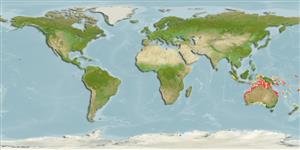>
Atheriniformes (Silversides) >
Atherinidae (Silversides) > Craterocephalinae
Etymology: Craterocephalus: Greek, krater, -eros = bowl, mixing vessel + Greek, kephale = head (Ref. 45335).
Environment: milieu / climate zone / depth range / distribution range
Écologie
marin; saumâtre démersal. Tropical
Western Pacific: Abrolhos Islands, Western Australia to Gulf of Carpentaria, Northern Territory, Australia.
Taille / Poids / Âge
Maturity: Lm ? range ? - ? cm
Max length : 8.5 cm TL mâle / non sexé; (Ref. 9760)
Épines dorsales (Total) : 5 - 7; Rayons mous dorsaux (Total) : 6 - 8; Épines anales: 1; Rayons mous anaux: 7 - 10. Gill rakers short, with spinules, 1-13 on first lower gill arch. Anus very close to origin of fin. Second dorsal fin with I spine, 6-8 rays; anal fin with I spine and 7-10 rays. Midlateral scales 29-33.
Essentially an estuarine species and coastal species, co-occurring with C. pauciradiatus, C. mugiloides and Atherinomorus endrachtensis. Biology not known except that it can withstand very high salinities. Probably taken as food by larger commercial species. (Ref. 9760).
Life cycle and mating behavior
Maturité | Reproduction | Frai | Œufs | Fécondité | Larves
Ivantsoff, W. and L.E.L.M. Crowley, 1999. Atherinidae. Silversides (or hardyheads). p. 2113-2139. In K.E. Carpenter and V.H. Niem (eds.) FAO species identification guide for fishery purposes. The living marine resources of the Western Central Pacific. Volume 4. Bony fishes part 2 (Mugilidae to Carangidae). FAO, Rome. (Ref. 9760)
Statut dans la liste rouge de l'IUCN (Ref. 130435: Version 2024-1)
Menace pour l'homme
Harmless
Utilisations par l'homme
Pêcheries: sans intérêt
Outils
Articles particuliers
Télécharger en XML
Sources Internet
Estimates based on models
Preferred temperature (Ref.
123201): 21.8 - 28.5, mean 26.9 °C (based on 258 cells).
Phylogenetic diversity index (Ref.
82804): PD
50 = 0.5000 [Uniqueness, from 0.5 = low to 2.0 = high].
Bayesian length-weight: a=0.00389 (0.00180 - 0.00842), b=3.12 (2.94 - 3.30), in cm total length, based on all LWR estimates for this body shape (Ref.
93245).
Niveau trophique (Ref.
69278): 3.0 ±0.4 se; based on size and trophs of closest relatives
Résilience (Ref.
120179): Haut, temps minimum de doublement de population inférieur à 15 mois (Preliminary K or Fecundity.).
Fishing Vulnerability (Ref.
59153): Low vulnerability (10 of 100).
